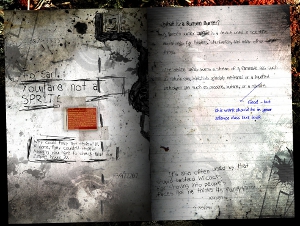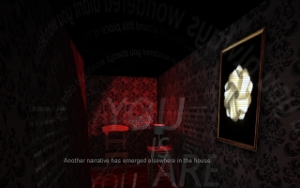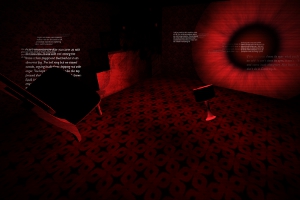



Featured image: Nightingale’s Playground Chapter Selection
Andy Campbell is a UK writer who has been experimenting with new media fiction since the 1990s, when he started creating stories on floppy disc for the Commodore Amiga. By 2000, when I first came across him, he was working mainly in Flash and self-publishing the results on a website called “Digital Fiction”. He has continued to produce one or two pieces of work per year ever since, latterly on a site called “Dreaming Methods”. His output is invariably enigmatic, complex, densely-textured, dark in tone and technically highly-accomplished; and he has gradually established himself, certainly amongst his peers, as one of the leading exponents of the digital fiction form.
His most recent work is also his biggest and most ambitious to date. Entitled Nightingale’s Playground, it consists of four interlinked parts: a click-and-read interactive story; a 3D “game”, which involves exploring a dark flat; a virtual exercise-book, the pages of which can be turned by dragging them across the screen with your mouse; and an ebook text narrative, written in short fragments.

The story, put simply, goes like this. In “Consensus Trance” (the click-and-read interactive section), the adult Carl has just broken up with his girlfriend. The one item he carries away from the breakup is an old red vanity case belonging to his Gran, with whom he used to live when he was a boy. The case contains bits of talismanic bric-a-brac dating back to Carl’s schooldays. Partly because the contents of the case have jogged his memories, Carl attends a school reunion in the hope of catching up with his best schoolfriend, Alex Nightingale. But Alex isn’t there – and furthermore nobody else can remember him. Carl remembers that Alex disappeared unaccountably while he was still at school. He begins to wonder whether Alex actually existed at all, or whether he imagined him; but at the same time he starts to feel as if “ordinary life” might be the illusion, and Alex might have disappeared because he somehow managed to get through to a further reality. He goes back to revisit the flat where Alex used to live.
“Consensus Trance II” picks up from inside the flat’s front door. It takes the form of a 3D “game”, in which we must walk through the passages and rooms of a half-dark flat, discovering fragments of white text as we go, and unlocking extra sections of the flat once a certain number of texts have been discovered. The text-fragments reprise parts of the story which can be found elsewhere, but they also develop the theme that Alex may have disappeared because he managed to get beyond the illusion of everyday life, along with a suggestion that Carl and Alex may be figments of one another’s imagination (many of the text-fragments have Alex’s name in them at one moment and Carl’s at the next), and a third idea that Carl may not be able to remember what happened to Alex because it was something so terrible that he blocked it out of his mind. In the last room of the flat, which has to be unlocked by discovering and “walking through” all the text-fragments elsewhere, this suggestion becomes more concrete: Alex may have tested out his own theories about reality by drinking something poisonous, and therefore he may have disappeared because he killed himself. The process of exploring the half-dark flat thus becomes a metaphor for Carl’s exploration of his own repressed memories, and the fragmentary revelation which awaits us in the last room represents the moment in which he rediscovers his personal nightmare.
The third part of the story, “The Fieldwork Book”, is an old exercise book of Alex’s – or rather a virtual exercise book, apparently recently dug-up, complete with soil-stains, scribbly handwriting, comments in blue from the teacher, doodles, bits of leaf stuck to the pages with sellotape, and woodlice running around on the front cover. It contains the beginnings of a school project about nature – “A dead tree may look lifeless, but actually it’s teeming with activity…” – along with notes from Alex to Carl – “Worthington has paired me up with this mad girl called Joanne. She smokes and stinks but I quite like her.” – and a lot of press cuttings and comments about a computer-game called The Sentinel. All of this makes more sense once the other parts of “Nightingale’s Playground” have been visited, particularly the ebook, which gives a lot of background information about both the Fieldwork Book itself and the Sentinel.
One thing we learn from the ebook section of the story is that The Fieldwork Book is a kind of changeling. Carl buried his science exercise book in the back garden behind his gran’s flat, at Alex’s suggestion, as a way of making it look more grubby and out-of-doors, and thus suggesting to the science teacher that it had been used intensively in the development of the nature project. However, when he dug it up again after Alex’s disappearance, what he discovered was not his own exercise-book but one belonging to Alex.
Another thing we learn is that The Sentinel, to which the Fieldwork Book makes numerous references, is an old Commodore computer-game with which Alex was obsessed. It had 10,000 levels, all based on the same principle: that players had to approach an object called The Sentinel across mountainous terrain without being observed. If they were detected the game would be over. Carl never managed to get very far but Alex managed to get to level 9,999 – and in fact one possible explanation for his disappearance is that it may have had something to do with him reaching level 10,000. He and Carl also played their own outdoor version of The Sentinel, in which Carl would have to stand still while Alex attempted to creep up on him undetected. A copy of The Sentinel is one of the items of bric-a-brac which Carl the adult discovers in his Gran’s old red vanity case.
The ebook also gives some more information about the vanity case itself. When Carl retrieves the Fieldwork Book and finds it to be Alex’s version rather than his own, he hides it in his Gran’s sideboard, and whilst hiding it he discovers something else in there – the red vanity case. The story doesn’t actually tell us in so many words that he looks inside the case, but we gather he must have done, because later on he has a conversation with his Gran, who is telling him that the contents of the case are private and he mustn’t look in there again:
“But what’s that red case? What are those papers?”
“They’re nothing,” she said insistently. “They’re from a long time ago, they don’t make any sense and they’re private love, they’re just private.”
The papers may have something to do with Alex’s death. On the other hand, they may be connected with Carl’s mother, since this is one of the few times in the story when she gets a mention:
…[Gran said] there were things in the world, happenings, that she didn’t understand, and neither would I, and neither would anyone else, and sometimes it was best to just leave them alone.
“Like we leave Mum alone,” I murmured. She didn’t answer that, and looked a little hurt, so I whispered “sorry” and she started talking to me again…
These hints are never developed further.
Nightingale’s Playground is not without its shortcomings. Its most obvious structural weakness is that its four different sections are in four different formats, each with its own distinctive “look” in terms of graphic design, and each needing to be viewed and interacted with in a different way. This is asking a lot of any readers and viewers who are unfamiliar with new media, although it’s actually less of a problem than might be supposed. Once the initial leap of faith has been made the cross-references between the four sections soon start to pull the story together into a surprisingly cohesive single structure. All the same, the fact that two parts are designed to be viewed online, whereas the other two parts are designed to be downloaded onto your own computer (or ereader) does make it a little bit inconvenient to shuttle backwards and forwards between one section and another if you want to examine the story in detail.

A more serious flaw is the fact that the Fieldwork Book doesn’t actually add very much to our sense of what’s going on. Pretty much all the information it contains (about the Sentinel, and Alex’s view of reality) can be garnered from the other sections, and although reading the Fieldwork Book gives us a slightly stronger sense of Alex’s personality and voice, the material in it begins to seem rather like padding on repeated viewing. There is a similar problem with the red vanity case, which is built up into something of great importance both in the point-and-click narrative section of the story and the ebook. When we actually get to see what’s inside the vanity case, halfway through the point-and-click section, the contents turn out to be rather disappointing.
Campbell does tend to talk up the importance of events and symbolic objects in his stories, rather than leave them to speak for themselves, which can sometimes backfire and lead to a sense of anticlimax. His prose-style can be overblown, a trait which is probably at its most noticeable in the “game” section of the story, where white texts either hang in the air or in some cases appear on the walls of the darkened flat. Some of these texts are particularly sonorous and doomy:
Where were we? Who were we? How much control did we have over the rain coming down, the hideous blank backdrop we were cut and pasted and glued against?
You were onto it, like you were onto something that meant all of this was wrong, some kind of mad illusion; that there was a staggering, amazing psychedelic hope going on that I desperately, weepingly wanted to understand.
I get the feeling everything changed then, like you said words to me that didn’t exist; a language that spoke the impossible; couldn’t be absorbed by the normal brain. Did you even invent some new words? Pierce a new crack in the fabric of what was going on in our limited, messed up world?
“The hideous blank backgrop”; “mad illusion”; “staggering, amazing psychedelic hope”; “desperately, weepingly wanted to understand”; “pierce a new crack in the fabric of what was going on” – the harder these phrases try to impress us, the less they succeed. The trouble is that there isn’t enough concrete observation or information here to convince us that the big emotive adjectives are justified. They seem to be flapping around in a vaccuum.
On the other hand, the ebook section of Nightingale’s Playground contains some of Campbell’s tightest and most effective writing:
Science was my best lesson because Alex was in it – science without Alex was a shitty prospect. I didn’t like any of the other kids in the class, I didn’t like the teacher, I didn’t like doing experiments or doing any work. Science for me was about swapping computer game cassettes under the table, scribbling rude shapes on Alex’s excercise book, whispering about whether the teachers were really aliens trying to brainwash us or whether the entire school was some kind of hologram that folded up and disappeared after the bell for hometime.
This is both convincing about the boredom of being a schoolkid in a dull lesson, and suggestive in terms of the story’s wider themes – the idea that “the entire school was some kind of hologram” clearly links to the alternative-reality theme. The ebook as a whole is written in short punchy sections jumbled into a non-linear sequence, shuttling us backwards and forwards through a term of so or Carl’s school memories, and unfolding (without ever fully explaining) the story of Alex’s disappearance. It works as a stand-alone, but it also works as the glue which holds the entire structure of Nightingale’s Playground together.

It should also be said that although the flat-exploring section of the story is sometimes overwritten, it is also the most thoroughly immersive of all four parts, and the one where Campbell’s characteristic approach to new media fiction comes into its own most strongly. He has always been at pains not to place his text in front of his images, or beneath them or to one side, like labels on tanks at the zoo or explanatory plaques next to pictures in a gallery; instead he puts his words inside his graphical environments, sometimes hidden or partially-hidden inside them, so that we have to explore to read. This avoids the danger of us regarding the texts as more important than the images. It pulls us in, and it makes his work inherently immersive and interactive.
This characteristic technique is taken a step further in the flat-exploring section of Nightingale’s Playground (which was built with gaming software called Coppercube 2.0), because here the three-dimensional space is deeper, more mazelike and more thoroughly-articulated than Campbell’s customary Flash environments. There is a sinister audio track which changes incrementally as we move from one part of the flat to another, enhancing our sense of three-dimensionality (the audio dimension of Campbell’s environments should not be overlooked in any of his work). The atmosphere is claustrophobic and scary. When you manage to find the right number of texts to unlock an extra section of the flat, there is a loud door-latch click which makes you jump even if you’re expecting it. When you get to the last room of the flat – the one where Carl is starting to get fragmentary recall of Alex’s possible suicide – the space is suddenly bigger, the predominant colour is red, there are items of furniture floating in the middle of the air, the far wall is decorated with a massive staring eye (an icon from the Sentinel game), the text-fragments tend to slide around in front of you as you approach them instead of staying still, and the whole effect is genuinely climactic and nightmarish. There can be no doubt that at moments like this Nightingale’s Playground is an extremely effective piece of new meda fiction.
It’s interesting to note how closely the climax of this flat-exploring sequence resembles Grandma’s house in Tale of Tales’ horror-game The Path. Campbell is an admirer of Tale of Tales’ work, but he hadn’t seen The Path prior to the completion of Nightingale’s Playground. All the same, the parallels are striking: the feeling of combined claustrophobia and disorientation, the sinister red-and-black colouring, the way the reader/viewer is barraged with suggestive fragments, and the way this technique is used to suggest flashbacks. There is a strong sexual theme in The Path which is not present in Nightingale’s Playground, but otherwise it’s difficult to escape the feeling that both Campbell and Tale of Tales have seized upon the exploration of a mazelike game-space as a metaphor for an inner journey, and have developed the metaphor in very similar ways.
Readers who are familiar with Campbell’s earlier work will recognise a number of the themes and motifs employed in Nightingale’s Playground. The Fieldwork Book, for example, is designed in very much the same way as an earlier virtual exercise book from a story called “The Scrapbook”; collections of fragmentary jottings, or old half-corrupted electronic files, can also be found in “Fractured”, “Floppy” and “The Incomplete”; the feverish boy being looked after by his Gran, with his mother either absent or not interested, is a familiar figure from “Dim O’Gauble”; the schoolfriend who introduces the first-person narrator to an apocalyptic secret is an echo of “Capped”; and a gloomy flat which must be explored for clues to the story’s central mystery can also be found in “The Flat”.

But these narrative strategies in turn suggest certain deeper patterns on which much of Campbell’s work seems to be built. His abiding interest in hints and fragments, for example, is admittedly suited to the nonlinear style of new media literature, but it also serves to suggest that Campbell’s central characters are often living in a reality with two layers: the “ordinary” everyday world which is mean, dull, shoddy and constricting, but relatively safe; and an inner or underlying reality which can only be glimpsed rather than viewed as a whole, possibly because it is so dangerous and frightening – a reality which emerges fitfully via dreams, games, imaginings and doodles.
It also frequently the case in Campbell’s work that the constricted dullness of the “ordinary” world is associated with adult life and adult sensibilities, whereas the “inner” reality is associated with childhood. Thus, in Nightingale’s Playground, the adult narrator starts to rediscover his “real” self when he breaks up with his girlfriend and rediscovers his memories of his best friend Alex. In a way, this could be seen as a Romantic or Wordsworthian view of the relationship between childhood and adulthood: as children we are much more in touch both with our imaginations and our inner selves, and therefore much more aware of the true nature of things, while as adults we become more absorbed in “getting and spending”, and therefore spiritually dull. Campbell is certainly no sentimentalist about childhood – in fact his stories are full of instances of kids being nasty to each other – and it should also be noted that the imaginative insights of the children in his stories may be shared or partially shared by more elderly figures such as the Gran in Nightingale’s Playground, another Gran in Dim O’Gauble, and the dying old man in Last Dream. It may be that these old people share the visionary capabilities of the young by virtue of their closeness to death – there are strong hints in the ebook section of Nightingale’s Playground that Carl’s Nan is about to die of lung cancer.
Perhaps a better literary antecedent for Cambell’s obsessive and visionary kids is the figure of Roland from Alan Garner’s Elidor – another hypersensitive and super-visionary outsider whose insight and talents serve to isolate him both from the mundane world of the Manchester suburb where he lives, and from the other members of his own family who would rather have safe, dull lives than dangerous, eccentric and magical ones. Of course Roland is an outsider-figure who can easily be identified with Alan Garner himself; and in the same way, Alex Nightingale can easily be identified with Campbell. The refusal of these visionary characters to settle for mere ordinary life can be interpreted as an oblique declaration of intent from the artists who created them. But there are other messages here too. The whole structure of Nightingale’s Playground is telling us something about the nature of the world we live in. Did Alex Nightingale actually disappear into an alternative reality, or did he commit suicide? Did Carl imagine Alex, did Alex imagine Carl, or did they both somehow imagine each other? Is the Sentinel just a computer-game or the key to something deeper? What was in the red vanity case when Carl first discovered it? What is the secret his Gran is so anxious to keep hidden? The fact that all of these issues are left hanging, and that the whole pattern of the story is therefore deliberately-unresolved, ambiguous, is a message in itself. Life isn’t clear-cut: it isn’t about answers: it’s about questions.
Nightingale’s Playground has its shortcomings, but it builds Campbell’s open-ended style of narrative into a more ambitious and absorbing structure – and explores some of his characteristic themes with greater maturity and depth – than anything he has produced before.
This review is co-published by The Hyperliterature Exchange and Furtherfield.org.